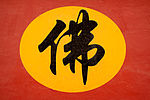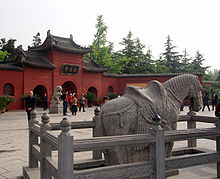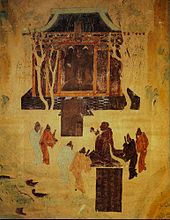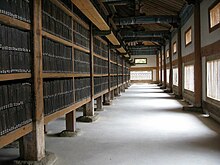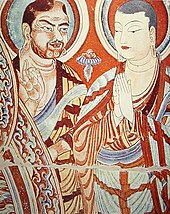History of Chinese Buddhism
Though Buddhism suffered numerous setbacks during the modern era (such as the widespread destruction of temples during the Taiping Rebellion and Cultural Revolution), it also experienced periods of reform and revival.
In 2004, Rong Xinjiang, a history professor at Peking University, reexamined the overland and maritime hypotheses through a multi-disciplinary review of recent discoveries and research, including the Gandhāran Buddhist Texts, and concluded: The view that Buddhism was transmitted to China by the sea route comparatively lacks convincing and supporting materials, and some arguments are not sufficiently rigorous.
[5] The French sinologist Henri Maspero says it is a "very curious fact" that, throughout the entire Han dynasty, Daoism and Buddhism were "constantly confused and appeared as single religion".
Wuwei, the Daoist concept of non-interference, was the normal term for translating Sanskrit nirvana, which is transcribed as nièpán (涅槃) in modern Chinese usage.
the scholar Fu Yi said: "Your subject has heard it said that in India there is somebody who has attained the Dao and who is called Buddha; he flies in the air, his body had the brilliance of the sun; this must be that god.
Harrison points to the enthusiasm in the Lokakṣema sūtra corpus for the extra ascetic practices, for dwelling in the forest, and above all for states of meditative absorption (samādhi).
They appear to have carried out a vast circling movement along the trade routes from Aparānta north-west into Iran and at the same time into Oḍḍiyāna (the Suvastu valley, north of Gandhāra, which became one of their main centres).
Kumārajīva revolutionized Chinese Buddhism with his high-quality translations (from AD 402–413), which are still praised for their flowing smoothness, clarity of meaning, subtlety, and literary skill.
It is noteworthy that before the modern period, these āgama were seldom if ever used by Buddhist communities, due to their Hīnayāna attribution, as Chinese Buddhism was already avowedly Mahāyāna in persuasion.
Due to the wide proliferation of Buddhist texts available in Chinese and the large number of foreign monks who came to teach Buddhism in China, much like new branches growing from the main tree trunk, various specific focus traditions emerged.
An important aspect of a nun was the practice of vegetarianism as it was heavily emphasized in the Buddhist religion to not harm any living creature for the purpose of them to consume.
[37] With the emperor's support, he set up a large translation bureau in Chang'an (present-day Xi'an), drawing students and collaborators from all over East Asia.
At the Longmen cave complex, Wu Zetian (r. 690–705) –– a notable proponent of Buddhism during the Tang dynasty (reigned as Zhou)–– directed mammoth stone sculptures of Vaircōcana Buddha with Bodhisattvas.
Printing from individually carved wooden blocks and from clay or metal movable type proved much more efficient than hand copying and eventually eclipsed it.
The school of teaching became a major force during the Tang dynasty with the Fifth Patriarch Hongren, his student Shenxiu who became the national teacher under the rule of Wu Zhetian, and the Sixth Patriach Huineng.
The Kaiyuan's Three Great Enlightened Masters, Śubhakarasiṃha, Vajrabodhi, and Amoghavajra, established Esoteric Buddhism in China from AD 716 to 720 during the reign of emperor Xuanzong.
Daxing Shansi was established in the ancient capital Chang'an, today's Xi'an, and became one of the four great centers of scripture translation supported by the imperial court.
Mantrayana altars were installed in temples in the capital, and by the time of emperor Tang Daizong (r. 762–779) its influence among the upper classes outstripped that of Daoism.
Nevertheless, Chan emerged as the most popular tradition within Chinese Buddhism, but with various schools developing various emphasises in their teachings, due to the regional orientation of the period.
[69] During the late Ming, a period of social upheaval, the monastery or convent provided shelter for these women who no longer had protection from a male in their family (a husband, son, or father) due to death, financial constraint, and other situations.
[70] There were also cases where individuals were sold by their family to earn money in a convent by reciting sutras and performing Buddhist services because they weren't able to financially support them.
In the latter half of the twentieth century, many new Buddhist temples and organizations were set up by these monastics, which would later come to become influential back in mainland China after the end of the Cultural Revolution.
Master Hsing Yun (1927–present) is the founder of Fo Guang Shan monastic order and the Buddha's Light International Association lay organization.
Master Sheng Yen (1930–2009) was the founder of the Dharma Drum Mountain, a Buddhist organization based in Taiwan which mainly advocates for Chan and Pure Land Buddhism.
The revival is mainly propagated by Chinese Buddhist monks who travel to Mount Kōya to be initiated and receive dharma transmission as acharyas in the Shingon tradition and who bring the esoteric teachings and practices back to Taiwan after their training has ended.
He established the Mantra School Bright Lineage the following year in Taiwan, which recognizes itself as a resurrection of the Chinese Esoteric Buddhist transmission rather than a branch of Shingon.
One example is the Taiwan-based organizations Tzu Chi Foundation and Fo Guang Shan, which were approved to open a branch in mainland China in March 2008.
With the rapid increase of immigrants from mainland China to Western countries in the 1980s, the landscape of the Chinese Buddhism in local societies has also changed over time.
For example, people of similar immigration experiences establish a Buddha hall (佛堂) within the framework of their associations for collective religious activities.
The second pattern features the transnational expansion of a large institutionalized organization centered on a charismatic leader, such as Fo Guang Shan (佛光山), Tzu Chi (慈濟) and Dharma Drum Mountain (法鼓山).
